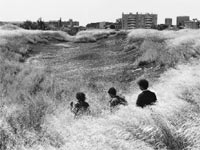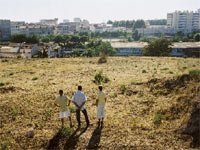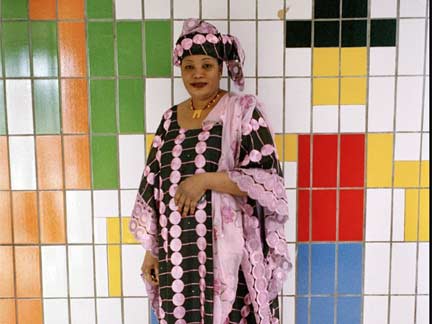"Ma proche banlieue" zooms in on French suburbs
by Alison Hird
Article published on the 2009-06-07 Latest update 2009-08-28 13:24 TU
Culture in France: Photographer Patrick Zachmann
"I’m a narrator. I like telling stories a lot," says Patrick Zachmann. And he tells them through pictures. The award-winning photographer, whose work for Magnum has included covering the Tiananmen Square massacre, has spent 25 of his 30-year career capturing the authentic face of France’s multi-racial suburbs.
Zachmann’s interest began in the 1980’s when French magazine Actuel commissioned him to represent the suburbs in a “modern and joyful” way.
“What I found were sad areas, desperately empty and I couldn’t manage to show the sunny side,” he says.
But he liked the idea of trying to change received images and avoid clichés.
So while the exhibition kicks off with a section called “Vu d’ailleurs” (Seen from elsewhere) showing video footage of how the 2005 riots in the suburbs were broadcast by Chinese and American TV stations, Zachmann’s less sensational lens quickly takes over.
One wall is devoted to Paysages de la banalité (Landscapes of banality). The series of brightly coloured wide-angle shots of service stations, industrial estates, roundabouts and railway lines, show the banal, cold, quiet and boring side to the suburbs.
The sun is often shining. On the opposite wall we see family portraits of some of the people that live there. The Sam family from Senegal, The Ly family from Vietnam, Mr and Mrs Evrard from Dunkerque whose faces are reflected in a kitsch 60’s sun-shaped mirror.
In the portrait of the Slimani family from Algeria, the mother sits large and proud in a leather armchair while husband and four children stand behind, almost to attention. Only the lamp stand with a bare bulb suggests they are of modest means.
Other photos pull back the proverbial curtains and give us a glimpse of banal but intimate home furnishings: a large black spider on a white net curtain, two teddy bears perfectly positioned on pillows on a pristine, newly-made bed.
In 2003, Zachmann was commissioned to do portraits of Malian women. Awa, Fama, Astan, Fanta and Niagaté live in Evry, south of Paris, but originate from Kayes in Mali. The women are a blaze of colour. “Their boubous contrast well against their often grey surroundings,” comments Zachmann.
When he went to Kayes in Mali to photograph the families “back home” he chose black and white however, as if the French Malians have taken on colour here, becoming a part of the French landscape. Although, as Zachmann points out, “in some ways they’re seen as foreigners when they go back home”.
In the early 80’s, Zachmann was commissioned to work with youth in Marseille’s rough northern neighbourhood, helping them with a course in photography. He had time to build up a relationship and get to know their families. Twenty-three years later he returned to find the likes of Hocine, Chérif and Yahia. The exhibition juxtaposes those recent photos with the early ones, and the results are both touching and edifying.

Chérif, Yahia and Hocine from the Bassens estate, north Marseille, September 1984
(Credit: © Patrick Zachmann / Magnum Photos)
“What shocked me was how they’d changed physically. They were quite good looking guys, quite joyful, they had hope. Twenty years later they’re marked. Life’s been difficult for them.”
Like Chérif. In 1984 he sits grinning on a bed, his arm proudly around his mother’s shoulder. In 2007, the pose is the same, but he’s lost a lot of teeth and his face is weathered and worn.
In the portrait of César, the change has been radical. A 1984 photo shows him looking mean and moody, James Dean like, leaning against tent ropes at the Fete de la Jeunesse. In the 2006 photo, he’s lying on the streets against a filthy wall. It’s a tragic end but Zachmann insists the visitor will at least know the identity of what would otherwise be just another faceless tramp.

Chérif, Yahia and Hocine from the Bassens estate, north Marseille, 23 years later, July 2007
(Credit: © Patrick Zachmann / Magnum Photos)
So what’s changed in the suburbs over those 25 years? In the case of northern Marseille the results aren’t encouraging. “On the whole it’s rather worrying,” says Zachmann. Not just the social conditions but “the perception from outside” has worsened. “A tiny section of the population has managed to install a climate of violence”.
The attitude towards photographers and journalists has also changed, he adds. “They used to appreciate you making an effort, taking the time. Nowadays it’s the opposite. Photographers and journalists aren’t always welcome. "
The sincere, un-sensational approach of a photographer like Patrick Zachmann could help restore faith in “outsiders” who are prepared to get to know their subjects, and leave the clichés for the mud-slingers.
Culture
Cracking skulls!
2010-02-15 12:35 TU
France's gothic avant-garde
2010-02-13 15:16 TU
Winter sounds warm up French jazz fans
A tribute to trumpeter Don Cherry at a Free Jazz showcase festival outside of Paris.
2010-01-31 11:55 TU
Trance on a trapeze
2010-01-30 12:41 TU
Retro Mobile - classic car exhibition
260,500 euros for rusty old car found at bottom of lake
A rusty old Bugatti, which spent years at the bottom of a Swiss lake, sold for 260,500 euros at the Retro Mobile classic car exhibition on Saturday. Other more lovingly-restored pristine examples are exciting enthusiasts from across the world in a special anniversary event at Porte de Versailles in Paris.
2010-01-23 20:21 TU
France's changing face looks east
2010-01-22 16:17 TU
Putting art on film
2010-01-20 13:09 TU
What sex is a coffee bean, where does the aubergine come from?
2010-01-08 16:08 TU
Cocteau Twin flying solo
2010-01-06 16:43 TU
A taste of Nordic filmmaking in Paris
Ciné Nordica 2009 at Paris’s Panthéon cinema showcases filmmaking from Scandinavia. So what makes Nordic film different from the rest?
2009-12-22 17:15 TU
















